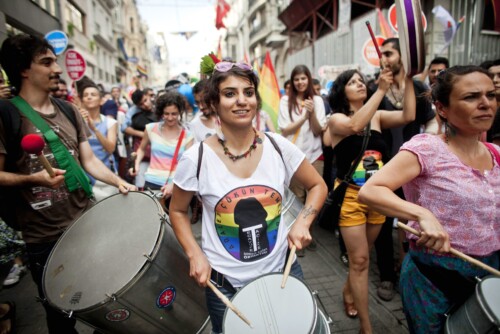We’re talking access to meaningful and fairly compensated work, quality education and healthcare, substantive participation in the political process, quality access to mobility … “Je me plains au monde:” “I stand in complaint before the world.” That’s my Left. I stand in complaint on all of these issues.
—Achebe Powell
We’re all this wild bundle and mixes of fantasies and possibilities and that’s what we have to explore. Saying the most important thing about you is that you’re gay or you’re lesbian puts you in a little box and prevents you from looking at any other aspects of who you are.
—Martin Duberman
There have been sexual outlaws, gender deviants, and same-sex loving people in politically radical or progressive movements throughout the history of the United States, whether or not they named themselves as such. From female-bodied soldiers in the Revolutionary army to female impersonators on the nineteenth century stage (who might today be named transvestite, gay, lesbian, or transgender), queer embodiment and desire were everywhere, including on the political left. The specific discrete identities of invert, homosexual, or transvestite did not emerge until the mid-nineteenth century in the United States, and those of transsexual, intersex, and transgender appeared later in the twentieth century. Influential leftist advocates for and representatives of these populations included socialist Edward Carpenter (who considered himself of the “intermediate” sex), writer Oscar Wilde, and anarchist organizer and intellectual Emma Goldman (among many others). Discussions and dissension over gender and sexual dissent occupied many anarchist, socialist, populist, labor, and communist groups in the United States through the first half of the twentieth century.
More recently, from the upsurge of organizing that both preceded and followed World War II, a multitude of self-identified sexual and gender dissidents have emerged, complicating any simple notion of how exactly a queer left might be defined. Achebe Powell and Martin Duberman are two prominent voices among the many that created the last half century of queer political life. They developed their thinking and activism in their travels through different political moments and movements, though they came together to help found Queers for Economic Justice in New York City in 2003. They both agreed to talk to me for this essay, outlining their experience and vision as queer left leaders.
Veteran social justice organizer and educator Achebe (Betty) Powell is founder and director of Betty Powell Associates, a diversity awareness and multiracial/multicultural organizational development consulting company. She started her career in progressive pedagogy teaching at both the high school and college level after receiving her MA in French from Fordham University in 1964. She has served as a co-coordinator of the New York City Black and Jewish Women’s Dialogue Group and as a member of the Multicultural Advisory Committee of the New York City Board of Education. Powell has decades of civil and human rights experience and she is one of the most visible and visionary black lesbian organizers in the United States. Recently, she emphasized that her mantra throughout her years working for social change has been: “I cannot stand here and talk to you only about gay liberation. I have to talk about the linkages between the black civil rights movement, the lesbian/gay liberation struggle, and the women’s liberation movement, in this country and globally.”
Martin Duberman, distinguished professor emeritus at the City University of New York (CUNY), taught for many years at CUNY’s Lehman College and Graduate Center. An award-winning historian, Duberman in the early 1970s risked his academic career by publicly joining his passion for progressive politics with his personal struggles to embrace his same-sex desires. He is the author of nearly two dozen works of biography, history, and memoir including The Worlds of Lincoln Kirstein, for which he was a finalist for the Pulitzer Prize in 2008; Paul Robeson; Stonewall; Cures: A Gay Man’s Odyssey; Midlife Queer; the historical novel Haymarket; a collection of essays published from 1964 to 2002, Left Out: The Politics of Exclusion; and, in 2009, two books: Radical Acts, a compilation of four of his plays (including the groundbreaking In White America, produced on Broadway in 1963); and Waiting to Land: A (Mostly) Political Memoir (1985-2008). He has published essays and reviews in The Nation, the Gay & Lesbian Review, Liberation, New Politics, The New Republic, and the Village Voice, among others. In 1986, after two decades of gay activism and scholarship, he founded the Center for Lesbian and Gay Studies at the Graduate Center of the City University of New York. As organizer, teacher, and writer, he helped define the parameters of the queer left for post-Stonewall activists. When asked about how to improve LGBT communities today, Duberman replied, “I think of it more in terms of what all Americans need rather than just LGBT people.”1
Both Powell and Duberman emphasize the interconnectedness of struggles for social change, a perspective grounded in mid-twentieth century progressive organizing in the United States, while simultaneously acknowledging the challenges of incorporating same-sex sexuality into movements for racial and economic justice.
A Short Select History of the Queer Left
The early days of the post-World War II queer movement reflect the ongoing tension between a focus on gaining acceptance and equal rights with a more expansive agenda that upends the status quo. In any history of mid-twentieth century queer left organizing, the mantle of queen of queer left activists most often has been draped around the shoulders of Harry Hay. A member of the Communist Party USA in Los Angeles in the 1940s, he adapted the CPUSA model of educating recruits in small secret groups, or “cells,” for the first ongoing gay organization in the United States—the Mattachine Society, founded in 1950. Mattachine, which was the first of the “homophile” groups of the 1950s and 1960s, moved on from its CP beginnings rather quickly. In the hostile climate of the Cold War, Hay resigned from Mattachine within two years of its creation so that his CP affiliation would not harm the education and organizing work underway. By 1953, some Mattachine members had purged the group of its remaining left activists entirely.
Also reflecting the Cold War culture of the era, none of the leaders of the feminist and all-female Daughters of Bilitis (DOB) openly identified themselves as leftists at the group’s founding in San Francisco in 1955. DOB’s bread-and-butter organizing tactics—which relied on socializing as well as social action—consisted of small meetings in members’ homes, large public gatherings, local and national publications, and media visibility. Some DOB leaders took their organizing skills into the plethora of progressive movements of the late 1960s, 1970s, and beyond, especially women’s liberation and lesbian feminism. This oscillation and conflict between liberal assimilationist reform, and more expansive left-influenced social justice organizing, has marked the ongoing history of LGBT/queer organizing in the United States.2
The late Allan Berube’s book, Coming Out Under Fire, brilliantly describes how the homophile organizations grew out of the conditions of World War II, when single-sex military service and mass mobility helped to lay the groundwork for a self-conscious modern gay and lesbian American identity and a new urban sexual culture.3 At the same time, influenced by the equal rights rhetoric and organizing of the black civil rights movement of the late 1940s, 1950s and early 1960s, queer people gained experience in the basics of activism. Those experiences created a foundation for the emerging homophile organizations and eventually for the upsurge in mass mobilizations in the decades to follow—mobilizations that often were led by and always included queers.
As the “new left” exploded onto the scene during the 1960s, many activists brought personal histories of working within liberal reform groups, while others came from the “old left,” with its range of communist, socialist, anarchist, anti-imperialist, antiracist, and other revolutionary ideologies and organizations. Whatever the mix of liberal and left influences in the new political insurgencies of the 1960s, one of the primary sources of disagreement was sexual politics. The flashpoint most often referenced is the Stonewall riot of 1969 in New York’s Greenwich Village, when queer outlaws, drag queens, underage hustlers, butch lesbians, and other denizens of the Stonewall Inn and the streets released years of bottled-up rage, resisting yet another instance of police brutality by fighting back for three consecutive nights, and made headlines.
Historian Ian Lekus challenges the popular tendency to isolate the sexual dissent that erupted during Stonewall from other new left issues and constituencies. Lekus explains that, “[t]hroughout the Sixties, LGBT people played critical roles in local and national student movements. Moreover, following the Stonewall riots, the gay liberation movement’s sweeping vision of democratic social transformation and ardent espousal of ‘coming out’ derived directly from its members’ experiences in the New Left….”4 Challenging received wisdom and ways of behaving were the hallmarks of 1960s radicals, and many of them embraced calls for “free love” and sexual liberation, perhaps without realizing that they were echoing the ideas voiced by Oscar Wilde and Emma Goldman more than a half century earlier. The failure to grasp such connections also obscured the consequences of introducing sexual politics into social change movements; some organizers, well known in the 1940s and 1950s for their radical antiwar activism and civil rights organizing—Bayard Rustin, for example—were vilified when their sexual desires were made public.5 Nonetheless, many leaders in the gay liberation and the women’s movement built on the concrete experiences they gained in earlier movements for social and economic justice. Achebe Powell and Martin Duberman are among these leaders.
- All quotations are from the author’s interviews with Achebe Powell and Martin Duberman, fall 2007. The interviews are excerpted and edited for brevity and clarity. For copies of the interview transcripts, please contact Queers for Economic Justice. [↩]
- Marcia M. Gallo, Different Daughters: A History of the Daughters of Bilitis and the Rise of the Lesbian Rights Movement (New York: Carroll & Graf, 2006). [↩]
- Allan Berube, Coming Out Under Fire (New York: The Free Press, 1990). See also John D’Emilio, Sexual Politics, Sexual Communities: The Making of a Homosexual Minority in the United States, 1940-1970 (Chicago: University of Chicago Press, 1983); Martin Duberman, Stonewall (New York: Penguin Books, 1993). [↩]
- Ian Lekus, “The Long Sixties,” OAH Magazine of History (Mar. 2006): 32-38. [↩]
- See John D’Emilio, Lost Prophet: The Life and Times of Bayard Rustin (New York: The Free Press, 2003). [↩]




